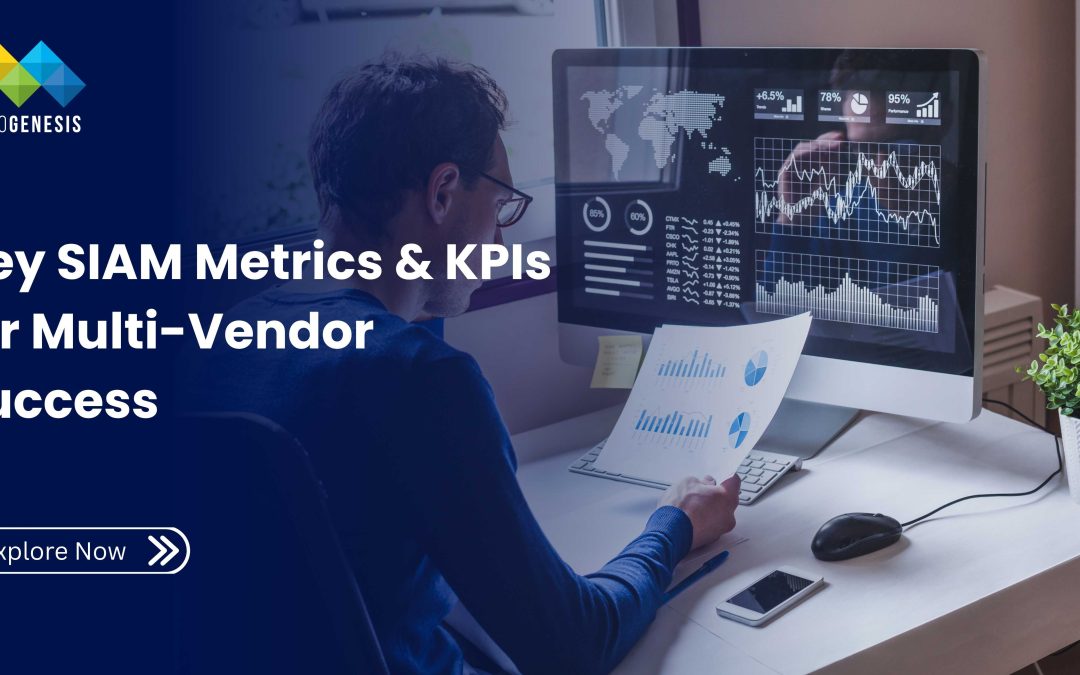In today’s digital enterprise landscape, service delivery rarely depends on a single provider. Most organizations work with multiple internal teams and external vendors to manage complex ecosystems of cloud platforms, infrastructure, and applications.
While this model promotes specialization and flexibility, it also introduces complexity: Who is accountable for end-to-end performance? How do you measure success across multiple providers?
This is where SIAM (Service Integration and Management) comes in — not only to unify service delivery but also to define clear, outcome-driven performance metrics.
In this comprehensive guide, we explore the most important SIAM metrics and KPIs that help organizations track performance, improve collaboration, and drive measurable business value.
1. The Importance of Measuring SIAM Performance
A successful SIAM implementation depends on quantifiable insights. Traditional IT performance metrics often focus on isolated provider performance — like server uptime or ticket resolution speed — but fail to capture the overall service experience delivered to the business.
SIAM shifts the measurement focus from siloed outputs to integrated outcomes by tracking:
End-to-end service performance, not individual components
Collaboration between vendors rather than competition
Business value realization, not just IT efficiency
Without these metrics, it’s impossible to know whether your multi-vendor model is creating synergy or friction.
2. Defining SIAM Metrics and KPIs
In a SIAM ecosystem, metrics should be:
Holistic – Measuring outcomes across the entire service chain
Consistent – Applied uniformly to all providers
Actionable – Guiding real improvements, not just generating reports
These metrics fall into several categories:
Service performance and availability
Collaboration and communication
Process efficiency
Business value
User experience
Let’s examine each in detail.
3. End-to-End SLA Compliance
Traditional SLAs often apply to individual vendors, but SIAM requires a unified SLA framework that spans all providers delivering a shared service.
Why It Matters
End-to-end SLA compliance reflects the true quality of service experienced by end users. It eliminates the “blame game” between vendors and ensures accountability for outcomes.
How to Measure
Define service chains (e.g., network, infrastructure, application, user support)
Measure total SLA compliance for the entire chain
Use shared dashboards to visualize SLA adherence
Example
A financial institution using multiple vendors for online banking found that while each provider met its individual SLA, overall customer satisfaction dropped due to latency between systems. By implementing end-to-end SLA tracking, they identified integration issues and improved uptime from 95% to 99.5%.
4. Cross-Provider Incident Resolution Time
In multi-vendor environments, incidents often span several providers. This KPI tracks how quickly and collaboratively vendors resolve cross-provider issues.
Why It Matters
Slow incident resolution directly impacts business continuity and user satisfaction. Cross-provider collaboration is often the weakest link in service restoration.
How to Measure
Track total time from incident logging to resolution
Record time spent in vendor-to-vendor handoffs
Analyze patterns in multi-vendor escalations
Improvement Tips
Establish joint incident management processes
Use shared ticketing systems and communication channels
Conduct post-incident reviews involving all vendors
5. Change Success Rate
Changes are constant in agile, cloud-driven environments. This KPI measures how effectively vendors implement changes without disrupting live services.
Why It Matters
A high change failure rate indicates process misalignment, poor testing, or lack of communication between vendors — all of which can lead to downtime.
How to Measure
Track number of successful changes versus total changes
Identify failed or rolled-back changes
Correlate change failures with business impact
Benchmark
Leading organizations target a change success rate above 95%, especially in mature SIAM environments.
6. Root Cause Identification Efficiency
This KPI measures the speed and accuracy with which teams identify and resolve the root cause of incidents.
Why It Matters
Quick root cause identification minimizes recurrence and strengthens long-term service stability.
How to Measure
Track average time to identify root cause after incident detection
Monitor percentage of incidents closed with documented root cause
Evaluate repeat incidents related to the same issue
Example
A global logistics company reduced recurring incidents by 35% after integrating a shared problem-management database accessible to all vendors.
7. Vendor Collaboration Index
Not all performance is numerical. Collaboration quality is a soft metric that reflects the maturity of relationships across vendors.
Why It Matters
SIAM thrives on cooperation. Competitive or siloed behavior among providers undermines shared goals.
How to Measure
Conduct periodic vendor and stakeholder surveys
Evaluate communication frequency, knowledge sharing, and responsiveness
Score providers based on participation in cross-provider meetings and joint initiatives
Pro Tip
Reward vendors not just for SLA adherence but also for collaboration excellence — for example, contributing to joint problem resolution or co-innovation.
8. Service Cost vs. Value Ratio
Financial accountability is crucial in SIAM. This metric measures the efficiency of spending relative to delivered business value.
Why It Matters
Optimizing cost without compromising service quality ensures sustainable vendor relationships and better return on investment (ROI).
How to Measure
Compare total service cost (across all vendors) with business outcomes, such as revenue impact or productivity gains
Track cost per incident, change, or transaction
Identify duplication or redundancy across providers
Example
An energy company discovered overlapping monitoring contracts across three providers. Rationalizing them reduced costs by 20% while maintaining service quality.
9. Time to Onboard/Offboard Vendors
Vendor onboarding and offboarding efficiency is a key indicator of SIAM maturity.
Why It Matters
Fast onboarding means new providers can begin delivering value quickly, while effective offboarding prevents service gaps and security risks.
How to Measure
Track the number of days to onboard a new vendor from contract signing to operational readiness
Measure offboarding time and residual access risks
Improvement Tips
Maintain standardized onboarding checklists
Automate access provisioning and knowledge transfer
Use common templates for contract and SLA setup
10. User Satisfaction (CSAT/NPS)
Ultimately, the most important measure of SIAM success is how satisfied users are with the services delivered.
Why It Matters
User experience reflects the combined effectiveness of all vendors. Even if SLAs are met, poor communication or inconsistent support can lower satisfaction.
How to Measure
Conduct regular Customer Satisfaction (CSAT) surveys after incidents or service requests
Use Net Promoter Score (NPS) to gauge overall loyalty and trust
Correlate satisfaction trends with operational data
Target: Maintain a CSAT above 90% or NPS above +30 for mature SIAM implementations.
11. Service Availability/Uptime
Service availability remains a core operational KPI that provides direct insight into reliability.
Dig Deeper: Cloud Infrastructure Support: Key to Sustainable IT in Europe
How to Measure
Monitor uptime across all systems, applications, and integrations
Include planned maintenance windows to calculate accurate availability
Measure impact of cross-vendor dependencies on overall uptime
Goal: Achieve 99.9% or higher uptime for mission-critical services.
12. Number of Cross-Provider Escalations
This metric tracks how often issues need to be escalated across vendors due to unclear ownership or disputes.
Why It Matters
Frequent escalations indicate governance or process gaps that undermine SIAM’s collaborative model.
How to Measure
Count escalation instances per reporting period
Analyze root causes — unclear roles, communication failures, or SLA misalignment
Improvement Approach
Clarify escalation paths within governance frameworks
Train vendors on shared resolution procedures
13. Measuring and Reporting Effectively
Metrics are only as useful as the insights they provide. Successful SIAM organizations focus on continuous improvement through regular reviews and transparent reporting.
Key Practices:
Use shared dashboards accessible to all providers and stakeholders.
Review metrics monthly in governance forums.
Tie operational KPIs to business outcomes — for example, faster resolution improves customer retention.
Encourage vendors to co-own metrics, not just report individually.
14. Building a Balanced SIAM Scorecard
A balanced scorecard integrates quantitative and qualitative KPIs to give a 360° view of performance.
Example Structure:
| KPI Category | Key Metrics | Target | Frequency | Owner |
| Service Quality | SLA Compliance, Uptime | 99.5% | Monthly | SIAM Manager |
| Efficiency | Resolution Time, Change Success | 95% | Monthly | Vendor Leads |
| Collaboration | Vendor Index, Escalations | +80 | Quarterly | Governance Board |
| Business Value | Cost vs Value, ROI | 10% improvement | Quarterly | CIO |
This unified view helps leadership track progress while keeping vendors accountable for shared success.
15. Conclusion
Metrics and KPIs are the heartbeat of SIAM success, transforming vendor management from reactive oversight into proactive value creation. With MicroGenesis, a top software company, organizations can implement data-driven SIAM strategies that enhance visibility, accountability, and service performance across multi-vendor ecosystems.
By focusing on end-to-end performance, collaboration, and measurable business impact, organizations can:
Improve cross-vendor transparency and accountability
Accelerate incident resolution and change success
Optimize costs while enhancing service quality
Foster a culture of continuous improvement
In the end, what gets measured gets managed — and in a multi-vendor world, the right SIAM metrics ensure that everyone is working toward the same goal: delivering exceptional, reliable, and value-driven services.

